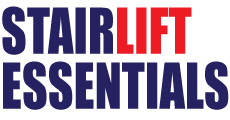What your options are for a stairlift for narrow stairs
If you are thinking of getting a stairlift and you have a narrow staircase in your house, you'll be pleased to hear that your chances of having one fitted are very good. But depending on what the width of your staircase is, you may be restricted to only certain types of stairlifts, some of which can be costly.
What is narrow for stairlifts
Any staircase which has a width of under 29 inches / 73 cm (this is the width of the tread of a step of the staircase which can be used to walked on, not the width from the wall/banister to the wall on the other side of the staircase) is regarded as narrow for stairlifts. This is the minimum width which most stairlift companies are willing to fit their standard (and cheapest) model of seated straight rail/track stairlift to.
The reason is for safety. If the width of the staircase is narrower than this, a standard seated stairlift poses a possible safety risk for the people actually using the it (e.g. banging knees against the banister or wall) and (more importantly) for the people walking up and down the stairs (e.g. knocking into the actual stairlift and tripping over the rail/track).
As most standard straight track/rail stairlifts are parked at either the top or the bottom of the staircase when not in use, there needs to be enough distance between the folded up seat and footplate of the stairlift and the opposite wall/banister to allow people to easily pass it without banging in to it. On narrow stairs, there isn't enough distance to do this.
Fortunately, there are two types of stairlifts which can be fitted to narrow staircases which means that this doesn't happen. But both come with some downsides.
A curved stairlift for narrow stairs
One solution is fitting a curved track/rail stairlift. With these these types of stairlifts, the track/rail can bend so the stairlift can be parked when not in use around the side of the staircase (at either the top or bottom) or further away from the beginning or ending of the staircase. As a result, there is enough space for people to safely use the stairs to walk up and down on.
This means that they can be fitted to narrower staircases than standard straight track/rail stairlifts can. There are some models on the market (e.g. the Thyssen Flow Curved) that can be fitted to stairs as narrow as 24 inches (61 cm).
The big problem about a curved stairlift, is the cost. To install one of these types of stairlifts on your stairs will cost you more (and sometimes a lot more) than double than what you'd pay for a standard straight trail/rail stairlift.
A perch stairlift for narrow stairs
Another option is a type of stairlift where you travel up and down the stairs not seated, but in a position where your are almost standing but your knees are slightly bent (like you would when seating on the edge of a bar stool). These are called perch stairlifts and can be safely fitted to staircases which are as narrow as 26 inches (around 66 cm).
Although this is a possible option for fitting a stair lift to a narrow staircase, they are generally more expensive (but less than you'd pay for a curved track/rail stairlift) than a standard seated straight track/rail stairlift and they are not ideal for everybody.
To find out more about perch stairlift, click here to read my article on perch stairlifts.
Alterations to the staircase
Because there is little space on narrow stairs, it is often common that before a stairlift can be fitted some alterations need to be made on or around the staircase for safety. This can be as minor as removing a hand rail to something a bit more complicated.
To find out more about alterations, click here to read my article on on possible alterations needed to install a stairlift.
Contact different stairlift companies
Unless your stairs are very narrow, you should be able to have a stairlift fitted on your stairs. The only way to find out for certain that a stairlift can be safely fitted (and what alertations need to be made or features the stairlift will need (like a hinged rail/track)) is get a number of different stairlift companies out to assess your staircase for suitability.
When you do this, make sure that you get at least 3 or 4 different reputable companies to do a site visit. By doing this you'll not only find out what your true options are (some stairlift companies have been known to convince people that their only option is to buy an expensive curved track/rail when they could have had a cheaper straight track/rail stairlift fitted instead) and you'll also end up paying less for the stairlift.

